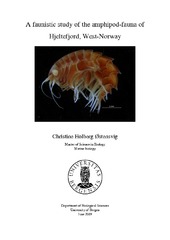| dc.description.abstract | Amphipods are a large and highly diverse order of benthic invertebrates. Their great variety in habitat selection, morphology, geographical range and feeding strategies makes them an important ecological group in marine soft sediments. Because their presence is important for the uphold of marine food webs through transfer of energy, it is essential to environmentally monitor these. This study focused on investigation of a community of amphipods in a fjord with the hope of contributing to the improvement of environmental monitoring conducted in Norwegian fjords. This is done by doing a thorough inventory of the fauna present at a fixed site in Hjeltefjorden, West-Norway and investigating the possible presence of seasonal variation. Lastly, it is discussed whether the seasonal variation is due to sampling efforts or actual biological factors. Nine samplings were collected in the time span between November 2017 to October 2018, with two replicates taken at each sampling. All samples were collected with an RP-sled. In addition, CTD-measurements were collected to assess abiotic factors at the study site. A total of 73 species from 29 families were identified showing a high diversity in species present. The family Ampeliscidae was most abundant in all samples and represented 48 % of all specimens collected. Two different indices of biodiversity showed no significant difference in the biodiversity between the sampling replicates. Species richness and species evenness varied between replicates, showing the highest richness in November and the highest evenness in April. The differences in species richness and abundance found throughout the year of sampling seems to be a result of both biological factors and sampling effort. Algal blooms appear to have a large impact on the community in autumn as this season had the highest species richness, highest abundance and many juveniles. Species within the same family showed similar variation in abundance, but there seems to be no shared variation pattern in the community. However, some variety in sampling effort could have affected the number of specimens collected. To give more certain results, more sampling over a larger time span should be conducted as this could reveal other patterns in the variation of the amphipod-fauna, and therefore improve the methods used for environmental sampling of these in Norwegian fjords. | en_US |
